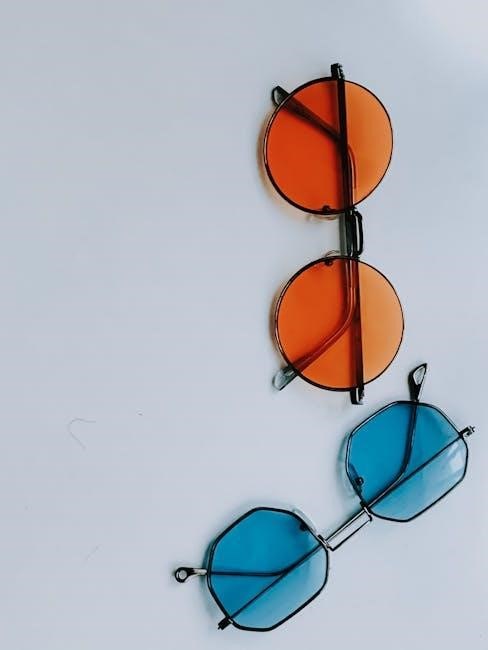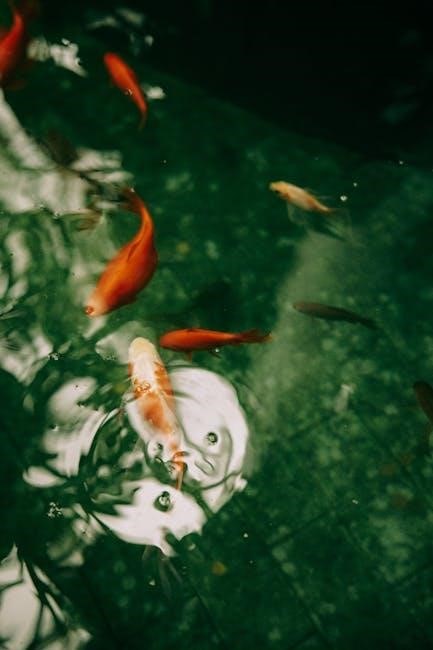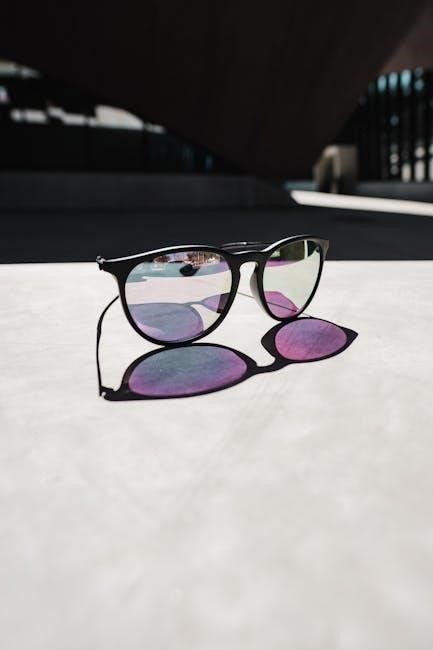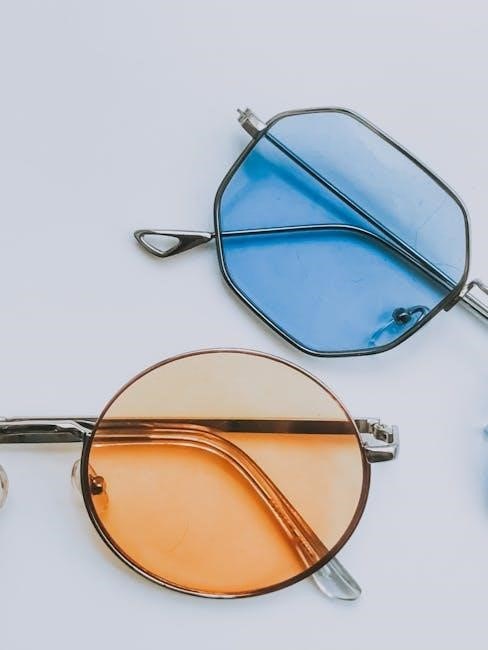Sunglass lens colors play a crucial role in fishing by enhancing visibility and reducing glare. Different tints suit various water conditions and light levels, improving fishing success. Choosing the right color increases clarity and reduces eye strain, making it essential for anglers to test options before selecting their perfect pair.
1.1 Why Lens Color Matters for Fishing
Lens color is vital for fishing as it enhances vision clarity, reduces glare, and improves contrast, allowing anglers to spot fish and underwater structures more effectively. Polarized lenses minimize surface reflections, giving a clearer view beneath the water. Different tints perform best under specific light conditions, with options like amber for low light and gray for bright environments; By optimizing visibility, the right lens color boosts fishing success and reduces eye strain, making it a crucial factor in selecting sunglasses for angling activities.
1.2 Brief Overview of Popular Lens Colors
Popular sunglass lens colors for fishing include amber, gray, yellow, and orange/copper. Amber lenses enhance contrast in low-light conditions, ideal for inshore fishing, while gray with blue mirror is suited for open water under bright sunlight. Yellow lenses excel in low-light situations, improving visibility, and orange/copper lenses adapt well to mixed conditions, offering balanced clarity. Each color is tailored to specific fishing environments, ensuring optimal performance and visibility for anglers.

Factors Influencing Lens Color Choice
Light conditions, water types, and personal fishing techniques significantly influence lens color selection. Each factor impacts visibility and comfort, guiding anglers to the most suitable tint for their needs.
2.1 Light Conditions and Their Impact
Light conditions significantly influence lens color selection for fishing. Bright sunlight requires darker tints like gray or blue mirror to reduce glare, while low-light conditions benefit from lighter colors such as yellow or amber, which enhance visibility. Overcast skies may call for orange or copper lenses to improve contrast. Understanding how light interacts with water and surroundings helps anglers choose the optimal tint for clearer vision and better fish spotting, ensuring a more productive fishing experience.
2.2 Water Types and Their Specific Needs
Water types significantly impact lens color selection. Inshore fishing benefits from amber or copper lenses, which enhance clarity in murky waters. Open water fishing requires gray or blue mirror lenses to combat intense glare. River fishing often calls for versatile green mirror lenses, balancing light and contrast. Each water type presents unique challenges, making it essential to match lens color to specific environments for optimal visibility and fishing performance. Understanding these needs ensures anglers can adapt their gear for varying aquatic conditions effectively.
2.3 Personal Preference and Fishing Technique
Personal preference and fishing techniques influence lens color choices. Anglers may prioritize comfort or aesthetics, while others focus on functionality. Techniques like sight fishing benefit from high-contrast lenses, while deep-sea fishing may require mirrored coatings for reduced glare. Some prefer versatile options like orange or copper for mixed conditions. Ultimately, the right lens aligns with both individual style and fishing strategy, ensuring a balance between visual performance and personal comfort during long fishing sessions.
Specific Lens Colors for Fishing
Various lens colors are suited for different fishing environments, with amber for inshore, gray with blue mirror for open water, yellow for low light, and orange/copper for mixed conditions, each reducing glare and enhancing vision.
3.1 Amber Lenses for Inshore Fishing
Amber lenses are ideal for inshore fishing, enhancing contrast and reducing glare in shallow waters. They improve visibility of underwater structures and fish, especially in low to medium light conditions. The warm tint reduces eye strain and is effective in cloudy or overcast environments. Amber lenses with green mirror coatings are particularly popular, offering versatility for both fishing and general use. They are a top choice for anglers needing clarity and comfort in variable lighting conditions near the shore or in estuaries.
3.2 Gray with Blue Mirror for Open Water
Gray lenses with blue mirror coatings are excellent for open water fishing, particularly in bright sunlight. They reduce glare from the water’s surface, enhancing visibility and clarity. The blue mirror adds a stylish touch while reflecting light, minimizing eye strain. This combination is ideal for high-light conditions, helping anglers spot fish more easily. It’s a popular choice for offshore fishing, where reducing reflections and maintaining sharp vision are critical for success in demanding marine environments.
3.3 Yellow Lenses for Low Light Conditions
Yellow lenses are designed to excel in low-light conditions, making them perfect for early mornings, late evenings, or overcast days. They enhance contrast and brightness, improving visibility in dim environments. This makes it easier for anglers to spot fish and underwater structures when natural light is scarce. Yellow tints are also beneficial for reducing eye strain caused by low-light glare, ensuring sharp vision and comfort during extended fishing sessions in challenging lighting conditions.
3.4 Orange/Copper Lenses for Mixed Conditions
Orange or copper lenses are ideal for mixed lighting conditions, offering a balance between contrast enhancement and glare reduction. They excel in intermediate light levels, such as during overcast skies or midday transitions, improving visibility and depth perception. These tints are versatile, making them suitable for both inshore and offshore fishing scenarios. They help anglers spot fish and underwater structures more effectively while reducing eye strain caused by varying light conditions, making them a reliable choice for dynamic fishing environments.
The Role of Polarization
Polarization is essential for reducing glare on water, improving visibility and clarity. It blocks reflected light, enhancing vision for spotting fish and underwater structures more easily always.
4.1 How Polarization Enhances Vision
Polarization reduces surface glare, enhancing underwater visibility by blocking reflected light. This clarity helps anglers spot fish and submerged structures more easily, even in bright conditions. By minimizing eye strain, polarization improves focus and visual comfort, making it indispensable for fishing in various water environments. The ability to see beneath the surface more clearly gives anglers a strategic advantage, making polarization a critical feature in fishing eyewear, especially for spotting fish in shallow or clear waters where light reflection is intense.
4.2 Benefits for Spotting Fish
Polarized lenses significantly improve the ability to spot fish by reducing surface glare and enhancing underwater visibility. This clarity allows anglers to discern shapes and movements beneath the water more easily. By minimizing reflections, polarization helps anglers detect fish in shallow waters, schools, or near structures. This enhanced vision is particularly advantageous in clear or sunny conditions, where glare typically obscures visibility, making it easier to locate and track fish effectively during fishing trips.
Mirror Coatings and Their Effects
Mirror coatings enhance lens performance by reducing glare and reflections, improving visibility in bright conditions. Green mirror offers versatility, while blue mirror excels in high-light environments.

5.1 Green Mirror for Versatility
Green mirror coatings offer exceptional versatility, making them ideal for various fishing conditions. They reduce glare effectively while maintaining color clarity, which is crucial for spotting fish in both clear and murky waters. Anglers appreciate their ability to perform well in both bright and moderate light, providing consistent visibility. This coating is particularly popular for inshore fishing and everyday use, as it balances style with functionality, ensuring optimal performance across different environments and lighting scenarios for anglers seeking a reliable option.
5.2 Blue Mirror for Bright Environments
Blue mirror coatings are designed for bright, high-glare environments, making them perfect for open water fishing. They effectively reduce reflections from the water’s surface, enhancing visibility and reducing eye strain. These coatings are often paired with gray or blue-tinted lenses, which are ideal for intense sunlight and clear water conditions. Anglers find them particularly useful for spotting fish in bright, sunny days, as they maintain color clarity while minimizing glare. This makes blue mirror lenses a top choice for offshore fishing and other high-light scenarios.


Combining Lens Colors and Mirror Coatings
Combining lens colors with mirror coatings enhances performance in specific fishing environments. Blue mirror with gray lenses excels in bright, open water, while amber with green mirror suits inshore conditions, balancing glare reduction and clarity for optimal vision.
6.1 Enhancing Performance in Specific Environments
Combining lens colors with mirror coatings optimizes performance for diverse fishing settings. Amber lenses with green mirror coatings excel in shallow, inshore waters by reducing glare and enhancing contrast. Gray lenses paired with blue mirror coatings are ideal for open water under bright sunlight, minimizing reflections. Yellow lenses boost visibility in low-light conditions, while orange/copper tints adapt to mixed lighting. Polarized options further reduce glare, improving clarity for spotting fish. Tailoring these combinations ensures anglers achieve superior vision tailored to their fishing environment, enhancing overall performance and success on the water.

Trying Before Buying
Testing sunglasses with various lens colors ensures proper fit and vision clarity. Trying them on helps anglers confirm comfort and optical performance before making a purchase decision.
7.1 Importance of Fit and Vision Testing
Ensuring a proper fit and testing vision clarity are vital when selecting sunglasses for fishing. A snug fit prevents slipping, especially on moving boats, while vision testing confirms that the chosen lens color enhances visibility and reduces glare effectively. Trying on different options allows anglers to assess comfort and optical performance, ensuring the sunglasses meet their specific needs for various fishing conditions. This step is crucial for maximizing functionality and ensuring a satisfying purchase.

Maintenance and Care
8.1 Tips for Longevity and Optimal Performance
Regular lens inspections and gentle cleaning with microfiber cloths prevent scratches. Storing in protective cases avoids damage, ensuring longevity and optimal optical performance.
Regularly clean lenses with soft, microfiber cloths to prevent scratches. Avoid using harsh chemicals or abrasive materials that can damage coatings. Store sunglasses in protective cases to prevent accidental damage. Inspect lenses for cracks or wear and replace them promptly if necessary. Avoid exposing sunglasses to extreme temperatures, as this can degrade lens materials. Proper care ensures optimal performance and extends the lifespan of your fishing sunglasses, maintaining their effectiveness in various fishing conditions.
Choosing the right sunglass lens color for fishing enhances visibility and comfort. Invest in polarized options, test different tints, and maintain your sunglasses for optimal performance and longevity.
9.1 Summarizing Key Points
Choosing the right sunglass lens color is vital for fishing success. Factors like light conditions, water types, and personal preference guide selections. Polarized lenses reduce glare, enhancing fish spotting. Testing different tints ensures optimal vision, while proper maintenance extends sunglass longevity. Balancing functionality and comfort helps anglers perform at their best, making informed choices essential for a superior fishing experience.
9.2 Final Recommendations
For fishing, prioritize polarized lenses to reduce glare and enhance fish visibility. Choose amber for inshore, gray with blue mirror for open water, and yellow for low light. Consider orange/copper as a versatile option. Test different tints and mirror coatings to ensure comfort and clarity. Maintain your sunglasses properly to extend their lifespan; By selecting the right lens color and features, anglers can optimize their fishing experience and performance in various conditions, ensuring both effectiveness and enjoyment on the water.